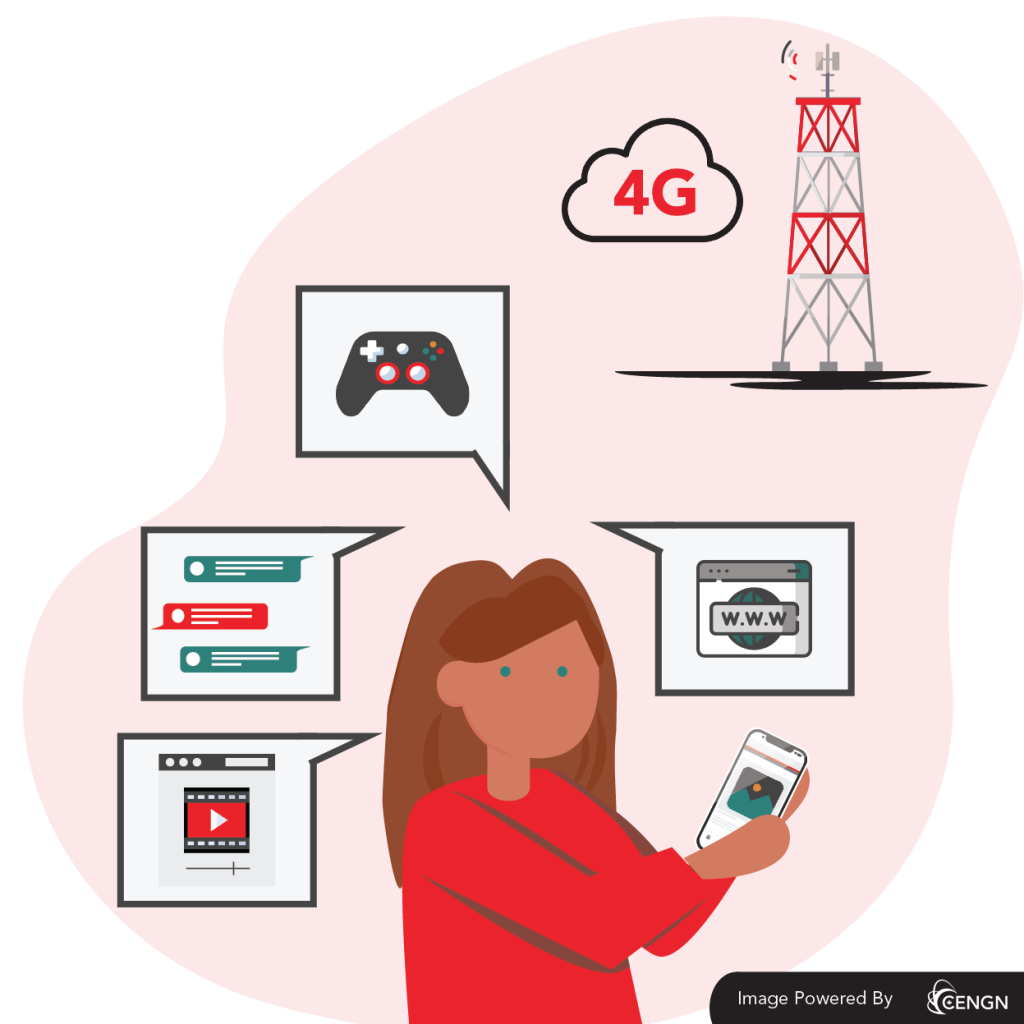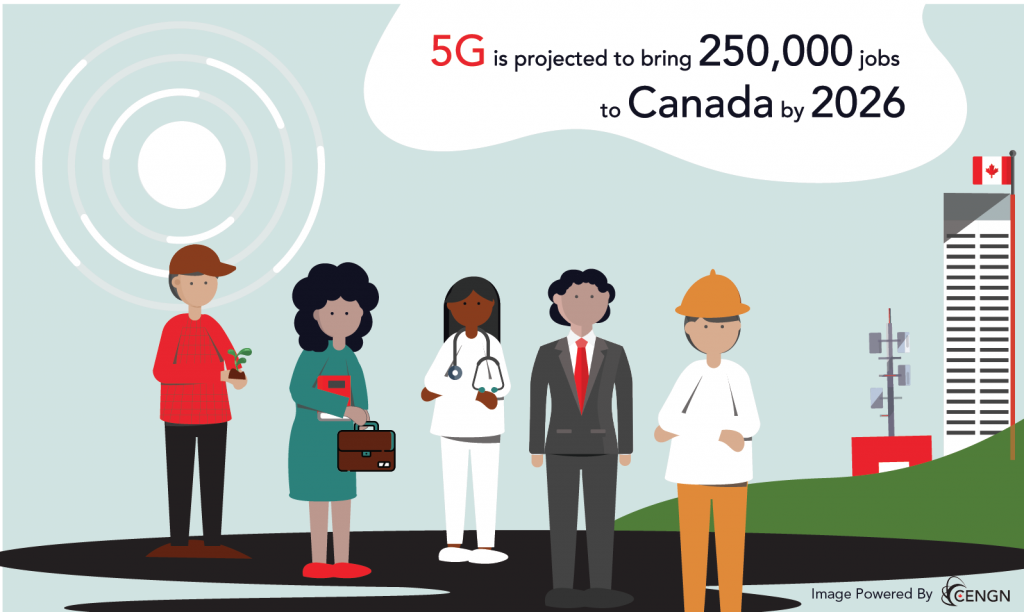More Innovation:
4G vs 5G: Connected and Protected
Updated: January 24, 2022
4G vs 5G: What’s the Difference?
As 5G in Canada continues, it’s important to understand the difference between 4G vs 5G. From improved speed to increased capacity, 5G offers better service and connection for Canadians, enabling success in all industries.
It’s common knowledge that 5G is an upgrade, but what makes it so much better?
Let’s dive in and compare 4G vs 5G.
4G: The Basics

Your current mobile network, 4G, was introduced for commercial use in Norway near the end of 2009. Starting at a minimum speed of 12.5 Mbps (megabits-per-second), 4G offers us all the services we use in our daily life (Source: ITU). Providing high-quality video streaming/chat, fast mobile web access, HD videos and online gaming, 4G is the steppingstone to its bigger and better ruler, 5G.
Interested in the history before 4G? Find out more on The History of Cell Phones and Their Cellular Generations here.
In Canada, the median 4G download speed was 55.5 Mbps reported in 2020 (Source: Speedtest). On average, 4G has a bandwidth of 200 Mbps, latency of 20-30 milliseconds, making it a strong connection, but there’s room for improvement.
Wondering where LTE fits in? 4G LTE stands for fourth-generation long-term evolution.
LTE is the industry jargon that describes the type of 4G that delivers fast mobile internet. Whenever you see your phone light up with “LTE” at the top of the screen, know that you’re using 4G.
We know that 4G LTE is fast. In fact, it’s 10 times faster than 3G. The giant leap forward with LTE has turned our phones into powerful connected devices, allowing us to do all the things we do today with our mobile phones.
But we are already onto the next great step in connectivity speeds. 5G has its foot in Canada’s door being introduced in major cities across the country.
Let’s cover the basic history.
5G: The Basics

South Korea first offered 5G in March 2019. With a bandwidth of less than 1 Gbps, latency under 10 milliseconds, a median download speed of 169.46 Mbps, 5G is 205% faster than 4G (Source: Speedtest).
To put it in simpler terms, imagine downloading a movie.
Downloading the average HD movie on a 4G network takes roughly 50 minutes, whereas downloading that same movie on a 5G network would take a whopping 9 minutes. No more stress downloading movies before travelling. 4G gets the job done, but 5G does it a whole lot quicker.
The big technical difference from 4G is that 5G offers a new digital system for transforming bytes (data units) over the air. With new radio interfaces and other technologies, 5G uses much higher radio frequencies to transfer more data over the air for exponentially faster speeds, lower latency, and reduced congestion.
Now that you know the basics let’s cover the physical hardware behind the scenes.
4G vs 5G: The Technology
Comparing 4G vs 5G, it’s ironic to call 5G bigger and better when it actually has a smaller physical reach than 4G towers. 4G towers operate at an average range of about 16km, whereas 5G towers operate at an average range of only 305 meters.
This difference in range limits the scope of 5G towers by about 98.5%, with the actual 5G towers being much smaller in size than 4G towers. Although more 5G towers are installed, their compact size makes them easily attachable to pre-existing structures.
Did you know 5G towers are better for the environment? Read more about 4 Ways 5G is Helping the Environment here.

5G is also a lot smarter. 5G uses a new digital technology called Massive MIMO: multiple input multiple output. Massive MIMO uses multiple targeted beams to spotlight and follow users around a cell site, improving coverage, speed, and capacity. In comparison, current 4G network technologies operate like floodlights, illuminating an area but failing to utilize signals effectively, creating wasted connectivity. This beam steering technology allows 5G signals to operate on your path rather than having to find a region that connects you.
5G doesn’t just improve the current networks we use; it brings new features to the table.
Network Slicing
5G enabled network slicing will allow end-users to slice a single physical network into multiple virtual networks, with each slice representing a different use. Splitting the network allows you to tailor speed, capacity, coverage, encryption, and security by reassigning resources from one slice to the next. This improves the overall efficiency of your network as services are prioritized with different sizes of slices to the user’s preference.
By splitting a network into multiple different slices, operations can become flexible based on the changing need of the end-user. Consider strengthening your video streaming slice during a big sports game and then moving those resources back to web and email during work from home hours.
Advanced IoT
IoT (Internet of Things) and 5G are a match made in heaven. 5G is an essential requirement of mass IoT sensor deployments needed for smart cities and other sensor-based technology, like autonomous vehicles.
IoT refers to interconnected devices, and with 5G, the future will be automated with machine-to-machine communications that involve connecting billions of devices that will alert and react to situations without any human intervention.

Picture this! You’re sitting in a car that drives itself, connects to the city’s traffic system, and delivers you to work where the smart building is already setting up your workspace automatically. With 5G, this is a nearby reality. With the increased connectivity, reliability, speed, and coverage, 5G will be the foundation to unlock the massive potential of IoT.
In 2018, the total number of connected devices reached 22 billion worldwide. Now, it’s projected to turn into 38.6 billion by 2025, and with the help of 5G, 50 billion by 2030 (Source: Telegraph).
More devices, more connectivity, more security.
Improved Security
With more networks, more regulation and security protocols are needed. 5G will deploy more private mobile networks and increase network access from third-party suppliers, ultimately increasing the opportunities for hackers to do their dirty work.
Luckily, network slicing is a hacker’s worst enemy. 5G SIM plays the ultimate role of protector of the user’s privacy. With your network in slices, you have more control over your data since each slice is individually encrypted. Instead of trying to hack one main network, each bit of the network is more secured.
Beyond this, 5G marks the beginning of a new generation of network security with the introduction of IMSI (International Mobile Subscriber Identity). This 5G security feature ensures that all traffic data sent over 5G radio networks are encrypted and integrity protected (Source: Ericsson).
5G is protecting our data and driving our economy forward.
4G vs 5G: The Future Moves Forward with 5G
With the many perks that 5G brings, like improved speed, capacity, latency, and security, countries and businesses see the technology’s major potential to drive economic growth.
5G offers the connectivity needed to enable innovations from small businesses that will advance production and efficiency across all industry and public services, opening up a wide field of new tech jobs and supercharging business and social prosperity.
5G has the potential to change our well-being through eHealth dramatically. Find out how through these 6 Ways 5G is Improving our Healthcare System.

It’s projected that 5G will optimize industries bringing an expected improvement to Canada’s GDP by $40 billion. 5G is also projected to bring 250,000 jobs to the Canadian economy by 2026 (Source: cwta).
4G is a steppingstone in our technology journey, but 5G is tomorrow’s accelerator.
Are you interested in hearing more about 5G and other innovative technologies?
Download our “Next Generation Network Imperative” Whitepaper to find out what the future of next-generation technologies will look like.
The International Data Corporation (IDC), a world-renowned global market intelligence firm, was commissioned to complete this study.









